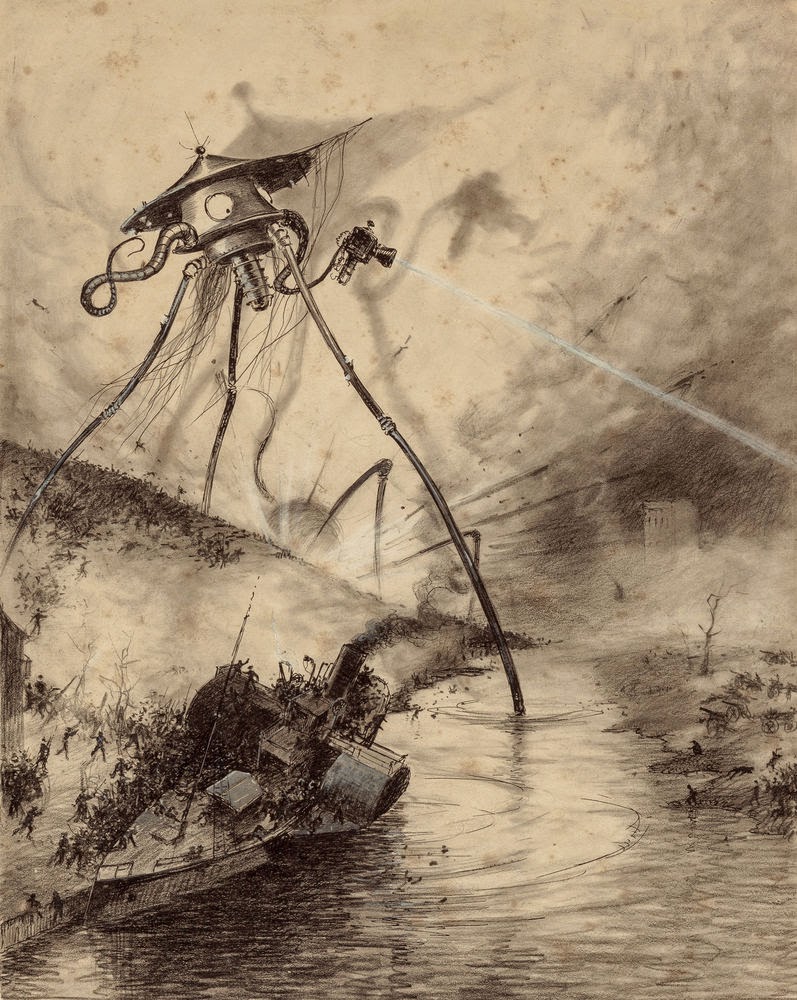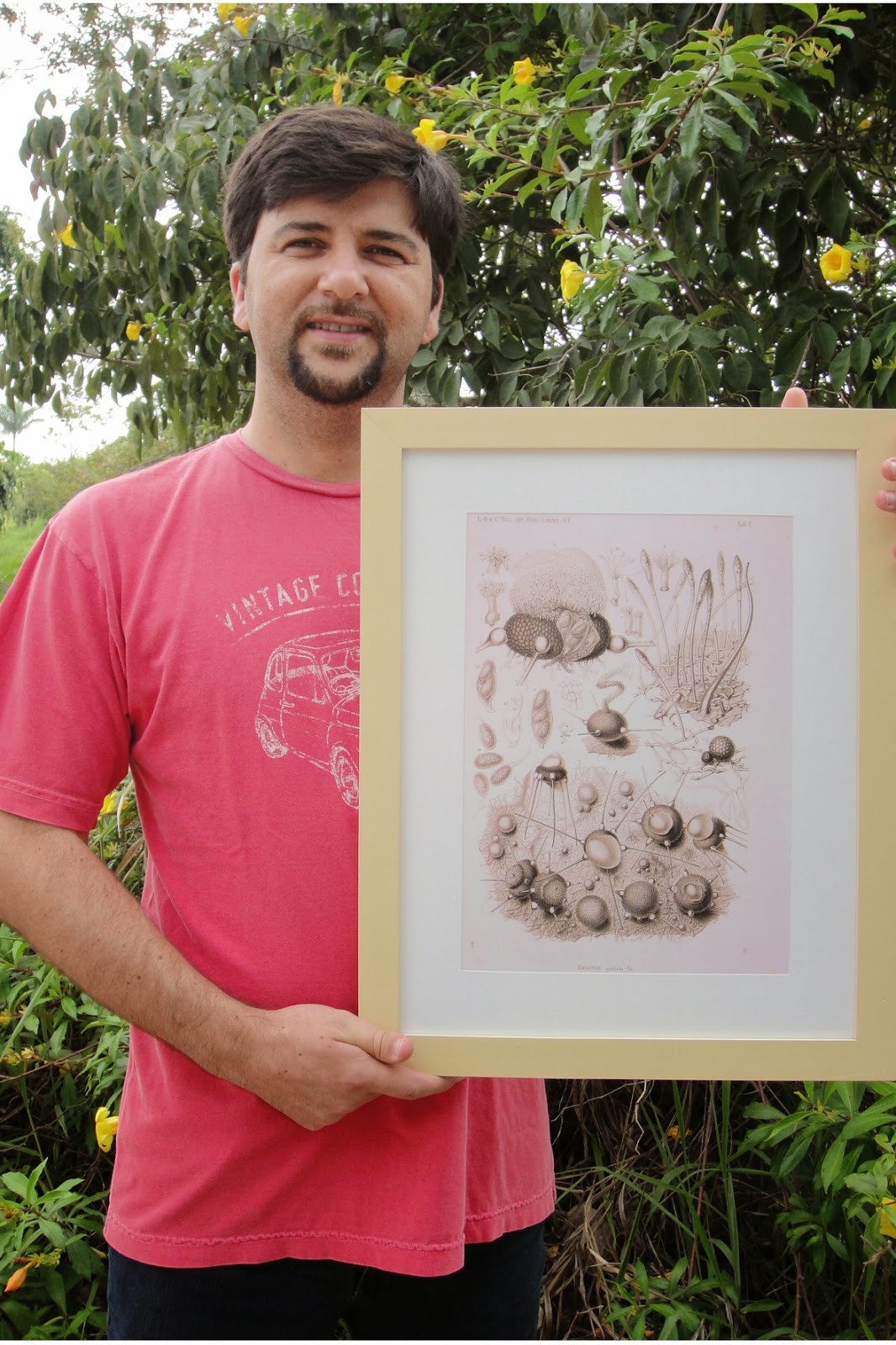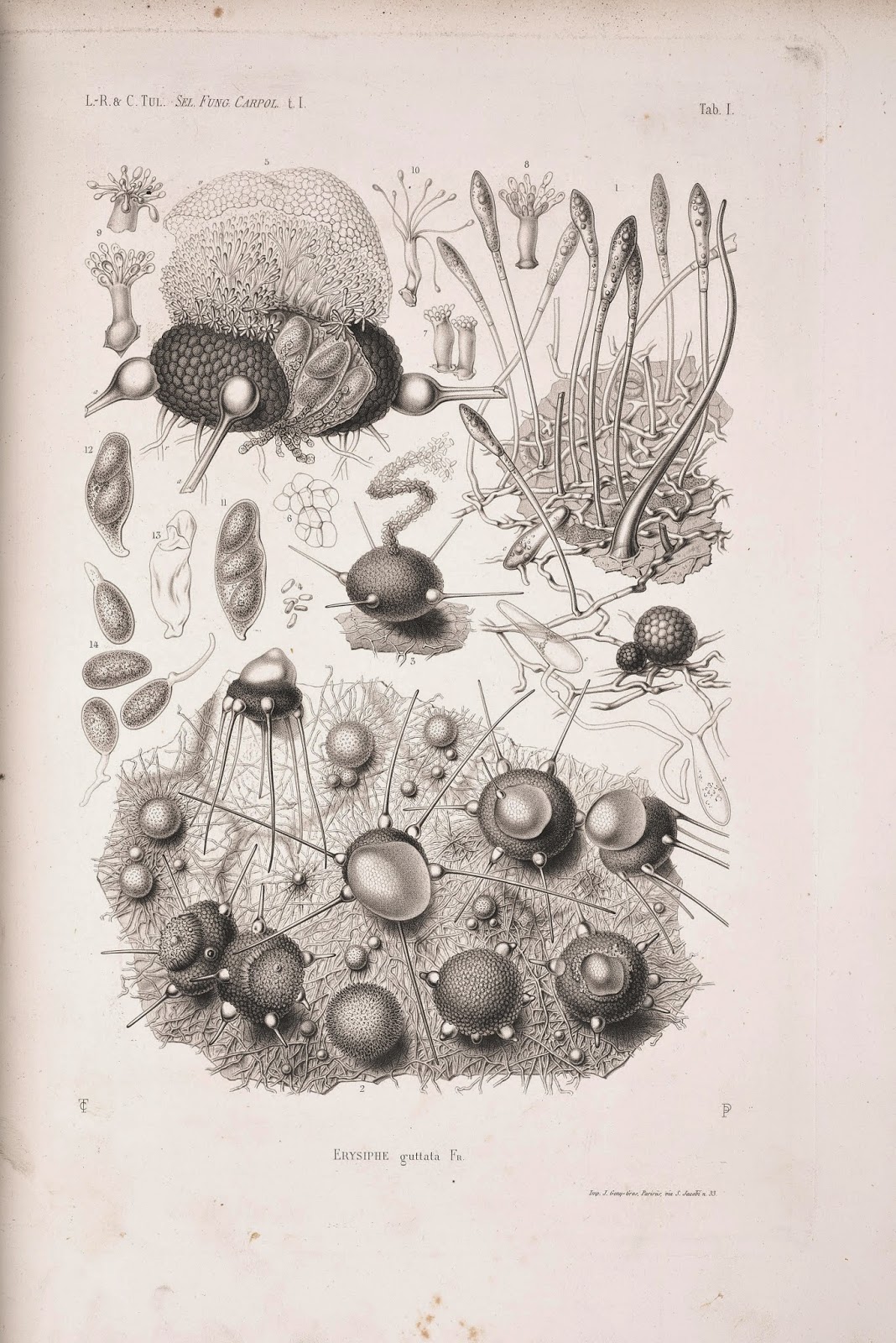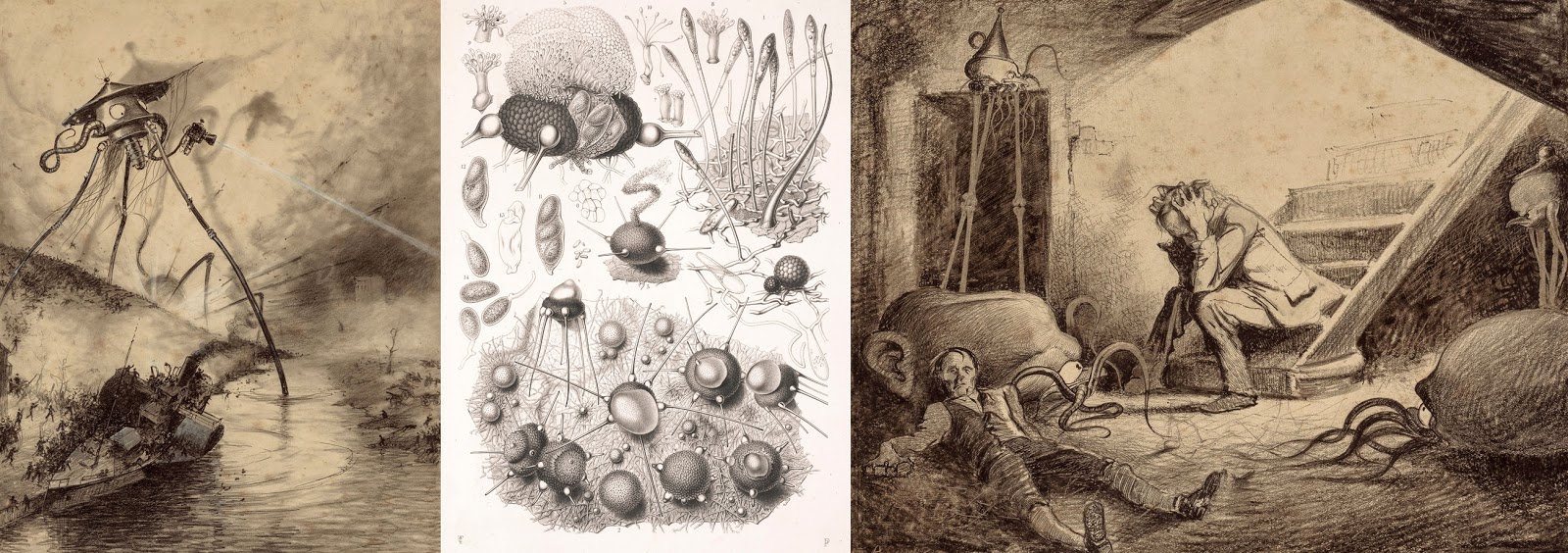Mars Invaders: The Wonderful World of Microfungi
In 1897, a monumental work appeared in print for the first time. It was a story of invasion. It was a story of war. It was a story of Martians.
The story, of course, was The War of the Worlds, by H.G. Wells, which first appeared in serialized form in the UK’s Pearson’s Magazine and the US’s Cosmopolitan magazine in 1897. It was later first published in book form by William Heinemann of London in 1898. Written between 1895-97, it is one of the earliest stories centered around conflict between humans and extraterrestrials. An extremely influential work, it has never been out of print.
The 1906 Belgian edition of the book included drawings by Brazilian artist Henrique Alvim Corrêa. His original pencil and ink drawings, depicting Martians wreaking havoc on a devastated Earth, are in fact going up for auction today in Beverly Hills, California, and are expected to realize a sum of $500,000.
 |
| Martian Gas Cannon, from The War of the Worlds, Belgium edition, 1906. Pencil and Ink drawings by Henrique Alvim Corrêa. Image from Heritage Auctions. Image obtained from: http://www.huffingtonpost.com/2015/05/05/war-of-the-world-illustrations-auction_n_7214410.html. |
Corrêa’s Martians, although largely mechanical, still have a very organic feel to them. Indeed, to the eyes of a trained expert, they bare a striking resemblance to something altogether earthly – microfungi.
Microfungi are fungi such as molds, mildews and rusts that differ from macrofungi by the absence of a large, multicellular fruiting body. Present in all terrestrial and freshwater and marine environments, microfungi grow in plants, soil, water, insects, cattle rumens, hair, and skin. Often benign, some species are also harmful, causing diseases in plants, animals and humans.
 |
| Fig. 1. Dr. Dartanhã J. Soares, plant pathologist researcher at the Brazilian Corporation for Agricultural Research (Embrapa), holding his new decoration piece which was downloaded through BHL from Tulane’s Brothers Selecta Fungorum Carpologia. Vol.1 http://biodiversitylibrary.org/page/3448217. |
Dr. Dartanhã J. Soares has been studying plant pathology for twelve years. While his post graduate research focused on the taxonomy of plant pathogenic fungi, these days his work is focused on the management of fungal diseases on tropical crops at the Brazilian Agricultural Research Corporation (Embrapa). But while his current duties may deviate from an exclusive study of fungi, Dr. Soares’ true passion is still mycology.
“I really love looking through the microscope and literally ‘discovering’ an amazing hidden world,” enthuses Soares. “But before that, I need to collect samples to be examined, and this is almost as exciting as looking through the microscope. I really like to go into the field and collect plant samples exhibiting the most variable range of fungal infection symptoms like those caused by rust and smut fungi. We can see some examples of symptoms and spore types in these drawings from the late nineteen century” (Figs. 2 and 3).
 |
| Fig. 2. Symptoms and spore diversity of rust fungi from Rust, smut, mildew and mould: an introduction to the study of microscopic fungi. By M.C. Cooke and illustrated by J.E. Sowerby. London, 1898. http://biodiversitylibrary.org/page/3275344. |
Soares’ research on fungi, and discovery of amazing illustrations like those from Rust, smut, mildew and mould (Fig. 2 and 3), are what led him to the Biodiversity Heritage Library about seven years ago.
“I was trying to solve a puzzle about a superficial black fungus I found colonizing the leaves of Typha dominguensis,” recalls Soares. “At that time, I had just finished my Ph.D. thesis and had enough time to dig into the Internet looking for ‘obscure’ things. I eventually came across G. Arnaud’s thesis Les Astérinées, available in BHL. The book itself did not help me as much as I needed, not only because it was in French, but also because the information I was looking for was only partially mentioned. However, it revealed another hidden world which was the amazing possibility to access landmark works about fungi, of course, that I would never be able to access by any other way. However, it is important to note that I did not discover the full potential of BHL at that time. That happened later, when I ‘found’ Reginald Buller’s Researches on Fungi. At that time, [I realized], ‘Hey, I’ve already visited this website before. Maybe I can find other landmark works on it.’ And then I started to dig a little deeper into BHL.”
 |
| Fig. 3. Symptoms and spore diversity of smut fungi from Rust, smut, mildew and mould: an introduction to the study of microscopic fungi. By M.C. Cooke and illustrated by J.E. Sowerby. London, 1898. http://biodiversitylibrary.org/page/3275364. |
Accessing BHL on average about once a month, Soares sees the true value of BHL through the ability to satisfy his curiosity about the natural world.
“BHL is a powerful tool and makes our lives easier,” explains Soares. “BHL is doing amazing work making such rare and wonderful ‘masterpieces’ available to everyone around the globe. Specific to my research field, BHL has a minor direct impact; sometimes it is necessary to check some old fungal description and in those cases I check BHL to see if the original work is available. However, indirectly BHL had a much bigger impact. BHL is providing me with a unique opportunity to improve my knowledge and mainly my curiosity about some classical works I had already heard about but never had the opportunity to read myself.”
While Soares most often uses BHL to download whole PDFs of books, one of his favorite features on the website is the multiple means through which he can access and download content and the breadth of materials available.
“BHL is very versatile in the ways it provides access to what I need,” lauds Soares. “Sometimes I read titles or parts of titles online, but more frequently I download the whole PDF to include the title in my personal digital library. More recently, I have also requested to download high resolution images because I was interested in having the picture framed. Additionally, at first I used BHL only for work or related topics, but now I see that there are a lot of interesting titles [outside of my direct field of study]. For example, some time ago I read the book The river of doubt: Theodore Roosevelt’s Darkest Journey by Candice Millard, and recently I saw that the book Through the Brazilian Wilderness, written by Theodore Roosevelt, is available at BHL. I have downloaded and started reading it.”
But while he loves the ability to download high resolution images from BHL, this feature also triggers a response from Soares on what he would like to see changed in BHL.
“The only thing I would change is the downloading process of high resolution images. It is a little tricky. It would be wonderful if we had the option to download high resolution images with one click, like: ‘click here to obtain this page in high resolution.'”
While we have recently released a tutorial better explaining how to download high resolution images from BHL, an easier way to provide access to these images is an item that we have added to our development wish list.
But what does all of this have to do with Martians and H.G. Wells? To understand, you have to consider Wells through the eyes of a fungi expert.
 |
| Fig. 4. Phylactinia guttata from Selecta Fungorum Carpologia. Vol.1, Tab.I, Tulasne, E.L.-R and C. 1861. http://biodiversitylibrary.org/page/34482177. |
“My favorite title [in BHL] is Selecta fungorum carpologia from the Tulasne brothers,” begins Soares. “The line drawings are so amazing, so ‘real,’ and with such richness of detail that I constantly ask myself how they did that with such rudimental microscopes. If you have any doubt about this, look at Erysiphe guttata, which nowadays is called Phyllactinia guttata, in Selecta Fungorum Carpologia Vol 1, Tab.I (Fig. 4). The sexual stage, the globose bodies, of this fungus are smaller than a pin head, and even so can you see the richness of detail? Additionally, the Tulasne brothers established the pleomorphism – which is the capacity of a single organism to show distinct forms – of fungi and summarized their results in Selecta fungurom carpologia, which became a landmark [title] on fungi research. Well, at this point, you’re probably asking yourself, where are the Martians? Don’t you see them? Look more carefully at Fig. 4. Does the general aspect of the sexual bodies of P. guttata remind you of anything? No? Well, maybe you should take a second look at some of the images from The War of the Worlds. Ha-ha, probably now you are wondering if H.G. Wells got inspirations from P. guttata to describe the invading martians, aren’t you?”
 |
| Comparing Corrêa’s Martians to Tulasnes’ fungi. Left: “Martian Gas Cannon.” Right: “Death of Curate.” Both from The War of the Worlds, Belgium edition, 1906. Pencil and Ink drawings by Henrique Alvim Corrêa. Images from Heritage Auctions. Images obtained from: http://www.huffingtonpost.com/2015/05/05/war-of-the-world-illustrations-auction_n_7214410.html. Center image: Phylactinia guttata from Selecta Fungorum Carpologia. Vol.1, Tab.I, Tulasne, E.L.-R and C. 1861. http://biodiversitylibrary.org/page/3448217. |
Thank you, Dr. Soares, for taking the time to explore the wonderful world of fungi and Martians with us! Do you use BHL to support your work? Want to tell us about it? Send us a message at feedback@biodiversitylibrary.org.





Leave a Comment